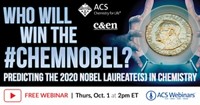Advertisement
Grab your lab coat. Let's get started
Welcome!
Welcome!
Create an account below to get 6 C&EN articles per month, receive newsletters and more - all free.
It seems this is your first time logging in online. Please enter the following information to continue.
As an ACS member you automatically get access to this site. All we need is few more details to create your reading experience.
Not you? Sign in with a different account.
Not you? Sign in with a different account.
ERROR 1
ERROR 1
ERROR 2
ERROR 2
ERROR 2
ERROR 2
ERROR 2
Password and Confirm password must match.
If you have an ACS member number, please enter it here so we can link this account to your membership. (optional)
ERROR 2
ACS values your privacy. By submitting your information, you are gaining access to C&EN and subscribing to our weekly newsletter. We use the information you provide to make your reading experience better, and we will never sell your data to third party members.
Biological Chemistry
Who owns CRISPR?
by Bibiana Campos Seijo
February 20, 2017
| A version of this story appeared in
Volume 95, Issue 8
“They have a patent on green tennis balls; we will have a patent on all tennis balls.”
That is how Jennifer Doudna, professor of chemistry and of molecular and cell biology at the University of California, Berkeley, reacted to the U.S. Patent Trial and Appeal Board’s recent ruling that Broad Institute, a research center affiliated with Massachusetts Institute of Technology, gets to retain more than a dozen patents that had been granted for the use of the technique known as CRISPR (see page 7). Short for “clustered regularly interspaced short palindromic repeats,” CRISPR is a way of editing DNA in the cells of humans, other animals, and plants.
Doudna was credited as an inventor of the gene-editing technology for work she did with Emmanuelle Charpentier, who used to be based at the University of Vienna but is now director of the Max Planck Institute for Infection Biology.
The pair, who shared the Breakthrough Prize in Life Sciences in 2015, were the first to propose that CRISPR could be used for programmable gene editing, allowing researchers to cut, insert, and remove genetic material with great precision. Broad’s Feng Zhang was the first to report its use in human cells.
The ruling states that the Berkeley and Broad patents do not overlap and thus the inventions that these two institutions are claiming are separate. The consequence of this ruling is that any organization wishing to use CRISPR technology in its research may need to apply to both institutions for licensing. Whether Berkeley will obtain patents for application of CRISPR to all types of cells remains to be seen, but Doudna’s tennis ball comment suggests they may be pursuing the broader interpretation of the patent.
The end of this long-running legal battle between Broad and Berkeley coincided with another important moment for CRISPR technology: the publication of a report green-lighting the editing of genes in human somatic cells (nonreproductive cells such as liver cells), which cannot be passed on to offspring, as well as the editing of sperm, eggs, and embryos to stop the transmission of inheritable diseases. This recommendation—authored by the Committee on Human Gene Editing, an advisory group formed by the National Academy of Sciences and the National Academy of Medicine—has the potential to remove barriers to research or at least clarify the ethical limits of this technology as well as to provide responsible governance as the field develops. You can read our analysis of the report on page 16.
And, if you want to talk authoritatively about all things CRISPR, please go back to last week’s issue, in which our cover story discusses how chemists and biotech experts are working together to overcome the challenge of getting the CRISPR gene-editing complex through cell membranes and into human cells. You can also find it online at cenm.ag/crispr.
Seeking Talented 12 nominations
Once you are up to date on your CRISPR knowledge—if you were not already—I’d like you to help us find C&EN’s next Talented 12.
This year will be the third edition of this accolade, which recognizes the talent of young chemical trailblazers from industry, government, and academia who are working to address problems far and wide in the chemical sciences. We’re searching for outstanding individuals who have the potential to shape the world we live in, so here is my request: Please nominate. Tell us what your nominee has done that’s special. Tell us how this person’s work is poised to impact his or her field and society. The 2017 nomination form is available at cenm.ag/t12nom and the deadline for submissions is April 1. We want to hear from you.
Views expressed are those of the author and not necessarily those of C&EN or ACS.




Join the conversation
Contact the reporter
Submit a Letter to the Editor for publication
Engage with us on Twitter